IUD Issues: Zero in with ultrasound
Pelvic sonography, especially transvaginal 3D imaging, is critical for identifying malpositioned and embedded IUDs.

Dr Shipp is a Vice President with Diagnostic Ultrasound Associates, PC, Brookline, Massachusetts, and a Sonologist and Associate Professor of Obstetrics, Gynecology and Reproductive Biology at Brigham & Women’s Hospital, Department of OB/GYN, Boston.

Dr Bromley is a Vice President at Diagnostic Ultrasound Associates, PC, Brookline, Massachusetts, and a Sonologist and Professor of Obstetrics, Gynecology and Reproductive Biology (part time) at Massachusetts General Hospital, Department of OB/GYN, Boston.
Neither author has a conflict of interest to report in respect to the content of this article.
Use of long-acting reversible contraceptives (LARCs) among premenopausal women has increased 5-fold during the past decade.1 The intrauterine device (IUD) is the most popular LARC, used by 6.4% of women aged 15–44 to prevent pregnancy.1 IUDs have also been proposed as a treatment for menorrhagia.2,3
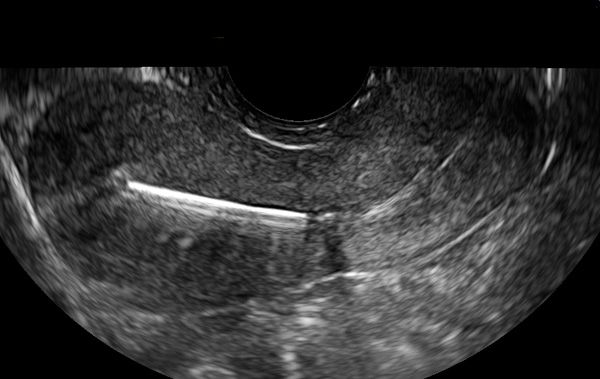
Figure 1A Transvaginal sagittal view of the uterus demonstrating the highly echogenic shaft of the ParaGard IUD.The 2 most commonly available types of IUDs in the United States are nonhormonal copper-containing devices (copper T-380A; ParaGard, Duramed Pharmaceuticals), and hormone-releasing systems Mirena and Skyla (Bayer HealthCare Pharmaceuticals Inc.). Both have a T-shaped polyethylene frame compounded with barium sulfate to make them radiopaque, enhancing their appearance by radiography but not by ultrasound.
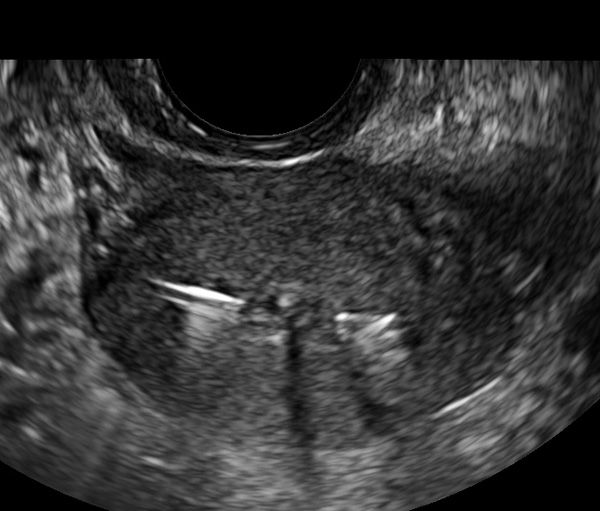
Figure 1B Transvaginal transverse view of the uterus demonstrating the highly echogenic arms of the ParaGard IUD.The ParaGard has a thin copper wire wrapped around the shaft and along a section of each of the straight arms, making it brightly echogenic by ultrasound (Figure 1 A,B,C). The Mirena and Skyla have slightly bowed arms and a central silicone reservoir around the stem that releases levonorgestrel (Figure 2,3).
The ParaGard and Mirena measure 32 mm across the arms and have a shaft length of 36 mm and 32 mm, respectively. The Skyla is slightly smaller with a transverse arm dimension of 28 mm and a length of 30 mm. In addition the Skyla has a sonographically visible small silver ring on the stem at the base of the arms. Monofilament retrieval strings are attached to the most inferior portion of the stem and can occasionally be sonographically recognized, depending on their location and other imaging characteristics such as the presence of cervical mucous (Figure 4).
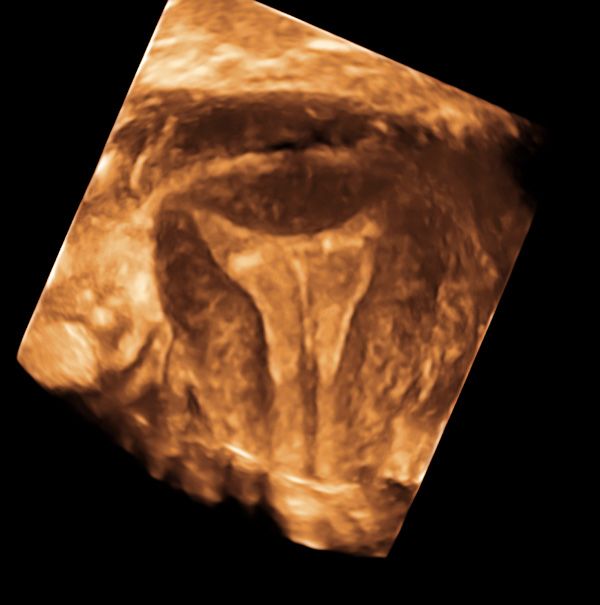
Figure 1C 3D coronal view of the uterus demonstrating the expected placement of the ParaGard IUD.IUDs are well tolerated by most women, with continuation rates of approximately 80%.2 Changes in menstrual bleeding may occur after placement of an IUD. Heavy bleeding and dysmenorrhea are more common with copper IUDs; amenorrhea is more common with progesterone-containing IUDs.3 Abnormal bleeding, pelvic pain, and inability to identify retrieval strings on physical exam may trigger a referral for imaging of the pelvis.4
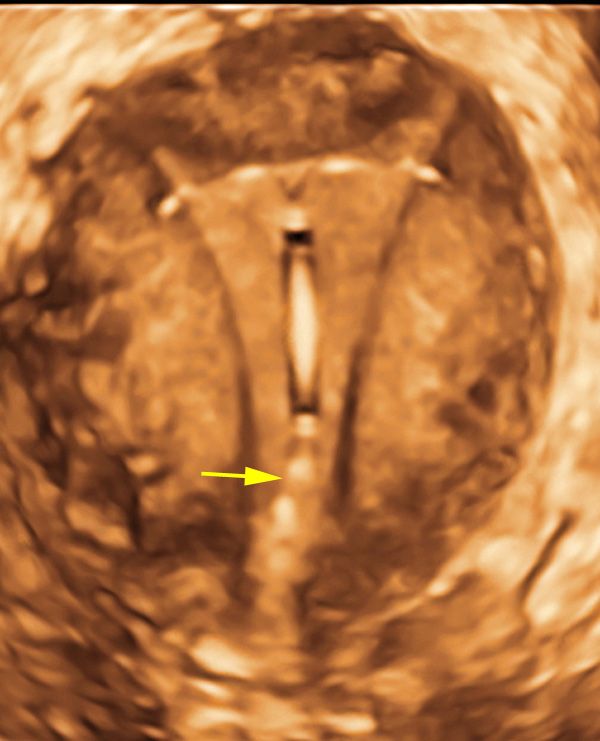
Figure 2 3D coronal view of the uterus showing normal placement of the Mirena IUD. The arms of the IUD are slightly embedded in the myometrium. String is demonstrated by an arrow.
Best technique for ultrasound evaluation
Sonography should be the first choice for imaging the female pelvis.5,6 It is readily available, much less expensive than other imaging methods, and does not place the patient at risk for radiation exposure. Multiple studies have demonstrated the utility of sonography in visualizing IUDs and characterizing their placement.4,7-11 Although most IUDs can be visualized with transabdominal ultrasonography, higher-frequency transvaginal ultrasound probes with resultant heightened resolution make transvaginal sonography optimal for evaluation of IUDs.
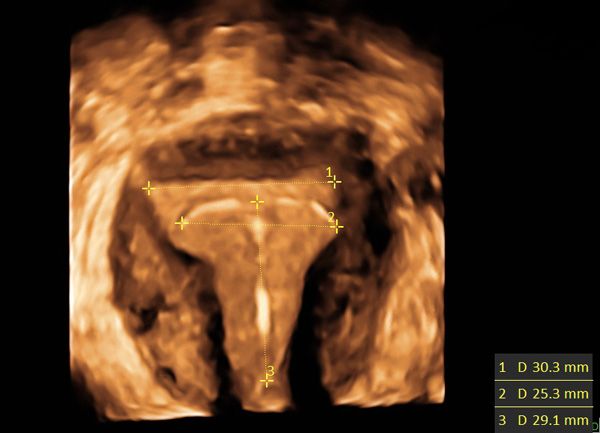
Figure 3 3D coronal view of the uterus showing normal placement of the Skyla IUD. The transverse diameter of the widest part of the endometrium is 30 mm.
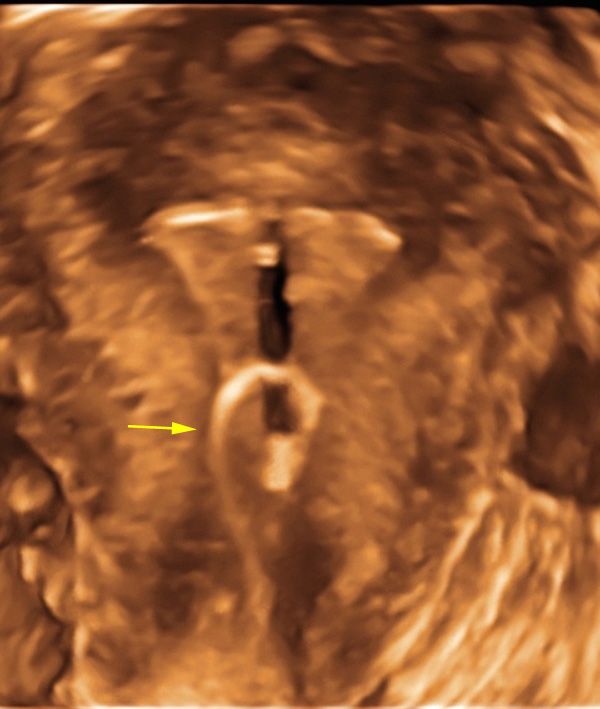
Figure 4 3D coronal view of the uterus showing normal placement of the IUD. The brightly echogenic string is visualized looping up and crossing over the shaft of the IUD and then extending toward the lower uterus (arrow).Sonographic evaluation of the positioning of an IUD is greatly enhanced by identification of the coronal view of the uterus, a plane that is not often obtainable using 2D imaging. Three-dimensional sonography allows visualization of the coronal view of the uterus with minimal post-processing manipulation of the uterine volume and is critical for determining malposition of an IUD.4-10
If an IUD cannot be visualized by 3D pelvic sonography, a secondary imaging procedure such as abdominal/pelvic x-rays or computed tomography may be necessary.10,11
Technique for coronal view
Abuhamad et al. have demonstrated the ease of attaining the coronal view of the uterus in a standardized fashion.12 To perform this so-called Z technique, follow these key steps:
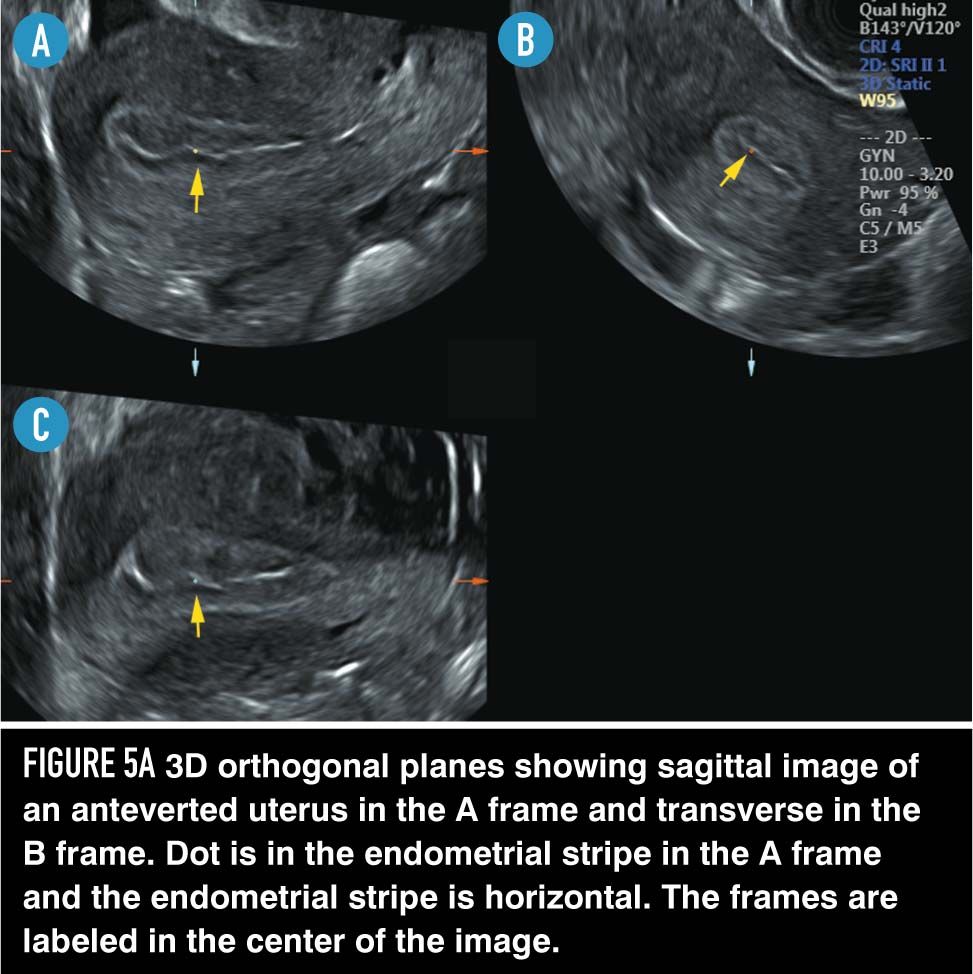
• Obtain a midsagittal view of the uterus and magnify the image so that it includes the corpus and lower uterine segment. Obtain a 3D image and display it in a multiplanar view so that 3 orthogonal planes are on a single frame. Configure the display so that the A frame is the acquisition plane (sagittal view), the B frame is the transverse view and the C frame is the coronal view. A “reference dot” located at the same anatomic point in each plane is the rotational point around which the image is rotated (Figure 5A).
• Place the reference dot in the midpoint of the endometrial stripe in the sagittal plane of the uterus, which should be in the “A” frame.
• Using the Z rotation, manipulate the sagittal view of the endometrial echo so that it is horizontal (Figure 5A).
• Place the reference or marker “dot” in the midpoint of the endometrial stripe in the transverse plane of the uterus, frame B (Figure 5B).
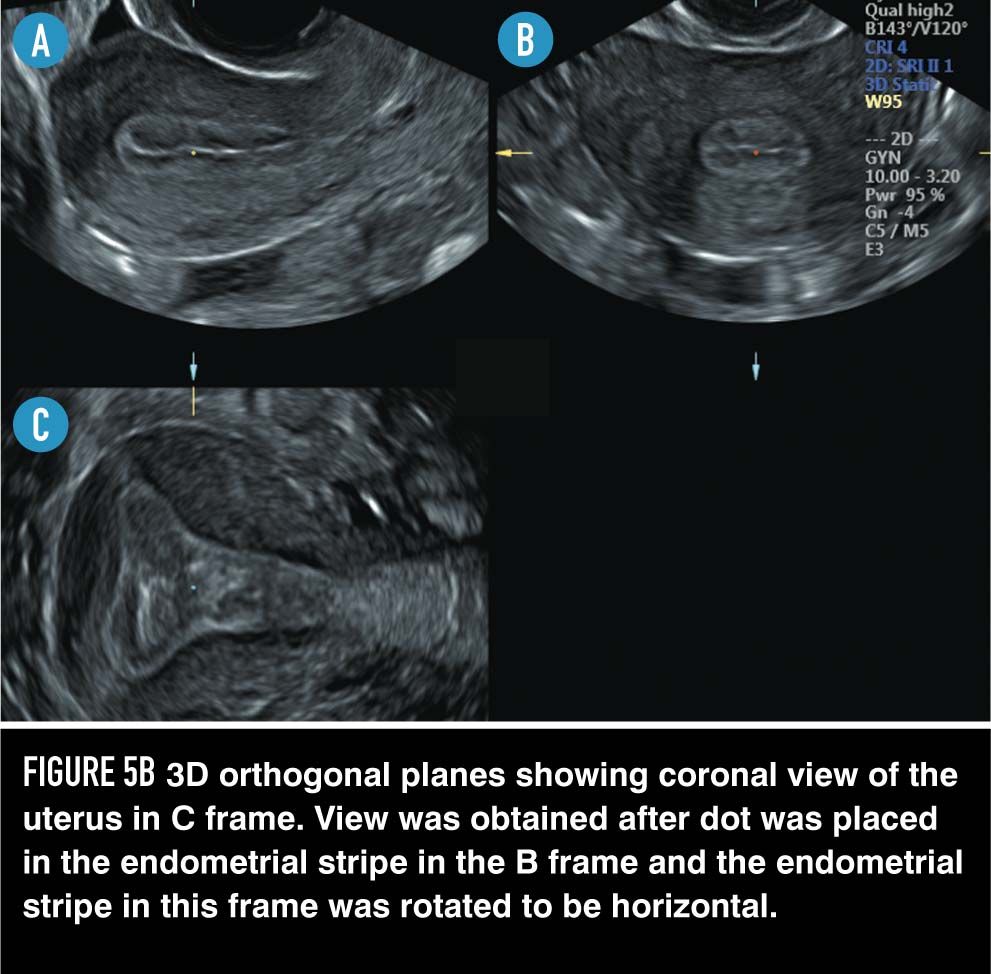
• Using the Z rotation, manipulate the endometrial stripe so that the short axis of the transverse plane is horizontal.
• You should now see the mid-coronal plane of the uterus on the C frame (Figure 5B).
• Use the Z rotation to manipulate the image so that it is demonstrated in the conventional orientation.
• You can then display the image as a single plane for optimal evaluation.
The coronal plane can also be demonstrated with a rendering technique using the same principles. In that case, adjustment of the position of the endometrial echo in boxes A and B is identical; however, the render mode is used and the line of interest is placed over the endometrium (Figure 6).

Given biologic variability, minor manipulation may be necessary to rotate all planes to obtain a coronal view of the uterus and check the position of the IUD. The same standard orientation is recommended for both anteverted and retroverted uteruses. Therefore the initial manipulation of the volume of a retroverted uterus should be approximately 180° so that the anterior wall of the uterus is at the top of the image, making it appear to be anteverted (Figure 7 A and B).
With this simple technique the coronal plane of the uterus can be obtained in almost all women after acquiring the volume during transvaginal sonography. If the IUD is in the expected location within the uterus, it should be easy to identify in the coronal plane. If the IUD is not in its expected location, further manipulation may be necessary to characterize its position and to ascertain its location. On occasion, an IUD is not in its expected location, and the “T-shaped” view of the device is not in the same plane as the coronal view of the endometrium and, therefore, they cannot be displayed in one image. In some cases, visualization of the acoustic shadow of the IUD may help in determining its location13 (Figure 8).
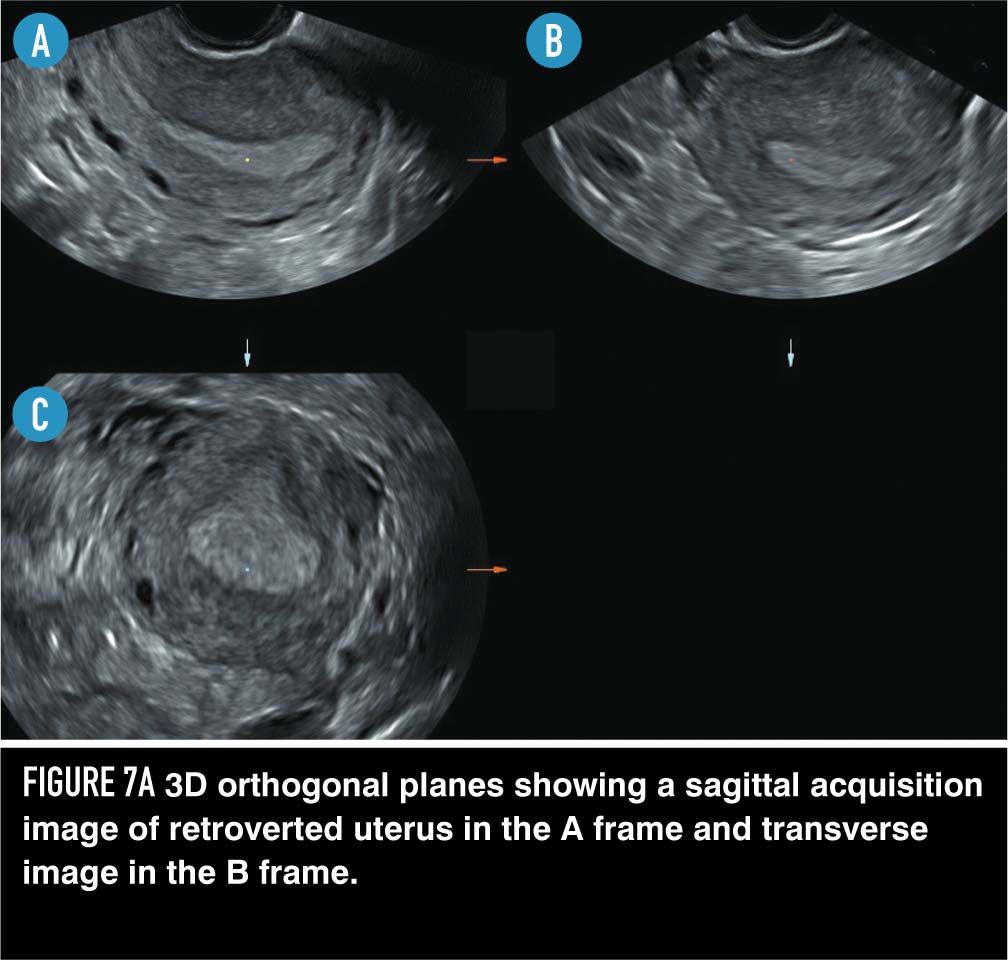
Important factors
Moschos and Twickler demonstrated that the copper T is more easily identified sonographically than the levonorgestrel-containing IUDs. These authors also showed that 3D sonography enhanced the “conspicuity” of both types of IUDs over conventional 2D ultrasound evaluation.8 Chen et al. evaluated malpositioned IUDs using the gold standard of hysteroscopy, laparoscopy, or laparotomy and found that 2D imaging correctly identified 65% of malpositioned IUDs whereas 3D ultrasound correctly identified 84% of malpositioned IUDs.9

Nowitzki et al. provided definitions for different types of abnormal or malpositioned IUDs.10
Expulsion: passage of the IUD either partially or completely through the external cervical os. The IUD is not seen on pelvic sonography.
Displacement: rotation or inferior positioning of the IUD in the lower uterine segment or cervix (Figure 8).
Embedment: penetration of the IUD into the myometrium without extension through the serosa.
Perforation: partial or complete penetration of the IUD through the serosa (Figure 9).
Fragmentation: retention of a broken piece of the IUD after expulsion or removal. Fragmentation of a retained IUD has been occasionally seen in vivo as well.14
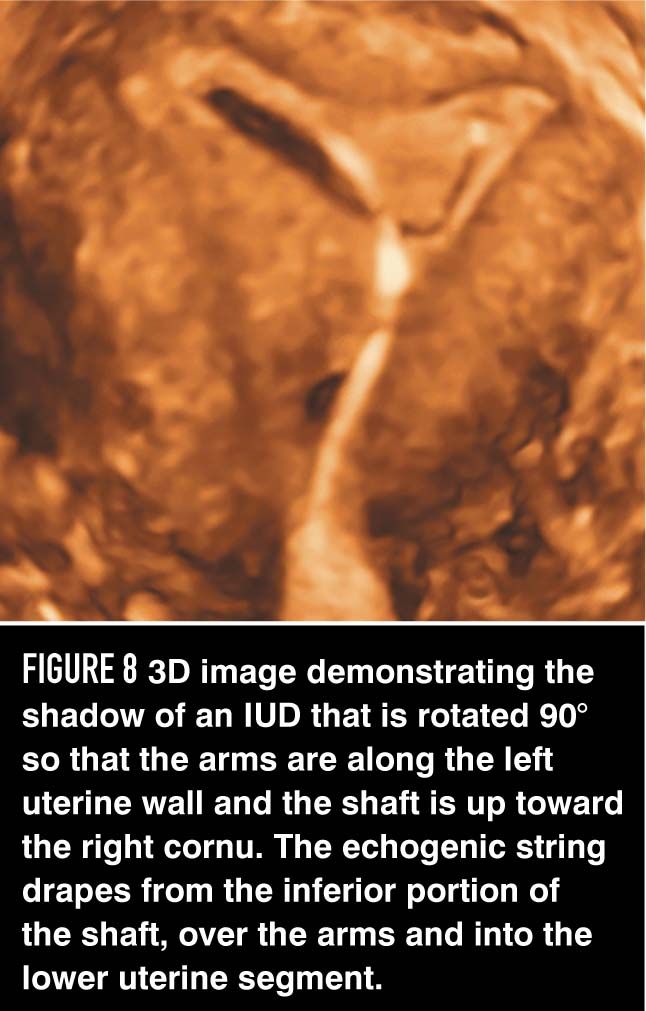
Displacement of an IUD from its expected location at the fundus of the uterus will almost always lead to some part of the IUD being embedded within the myometrium. Complete perforation may be difficult to identify by ultrasound because the surrounding bowel can hamper or prevent visualization. In these cases, other imaging modalities may be necessary.10,11
When a patient has an IUD and is referred for abnormal bleeding and pain, it is important to determine if the IUD position could be associated with the symptoms. Benacerraf et al. demonstrated that 75% of patients with an IUD referred with either pain or bleeding had a malpositioned IUD as compared to 35% of those without those symptoms.4 Braaten et al. demonstrated that malpositioned devices were present on 10.4% of scans among women having pelvic sonography for any indication and were usually in the lower uterine segment. In that study, approximately two-thirds of malpositioned IUDs were removed, resulting in a higher rate of pregnancy (due to non-initiation of another effective contraceptive method) as compared to those with normally positioned IUDs.15 In addition, malpositioned copper devices have decreased contraceptive efficacy if not located in the uterine fundus.16
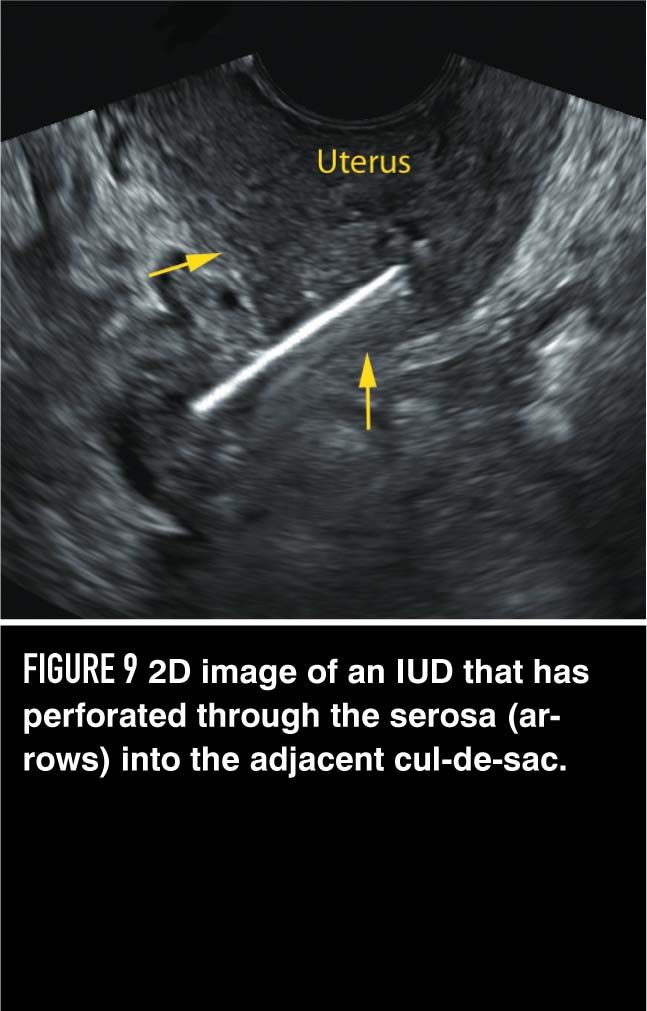
Shipp et al. demonstrated that the endometrial cavity was narrower in patients with embedded or malpositioned IUDs as compared to those with normally positioned IUDs.7 Liang et al. demonstrated that women with larger transverse diameters of the coronal view of the uterus have a higher risk of IUD expulsion.17 Patients who are clinically suspected of having a small or large uterus may benefit from a pre-IUD insertion ultrasound to assess the maximal width of the endometrial cavity. This information may help determine the size of IUD that should be inserted or even whether an IUD is a reasonable option (Figure 10). Ultrasound may also be helpful for evaluation of IUD placement in women with uterine anomalies.
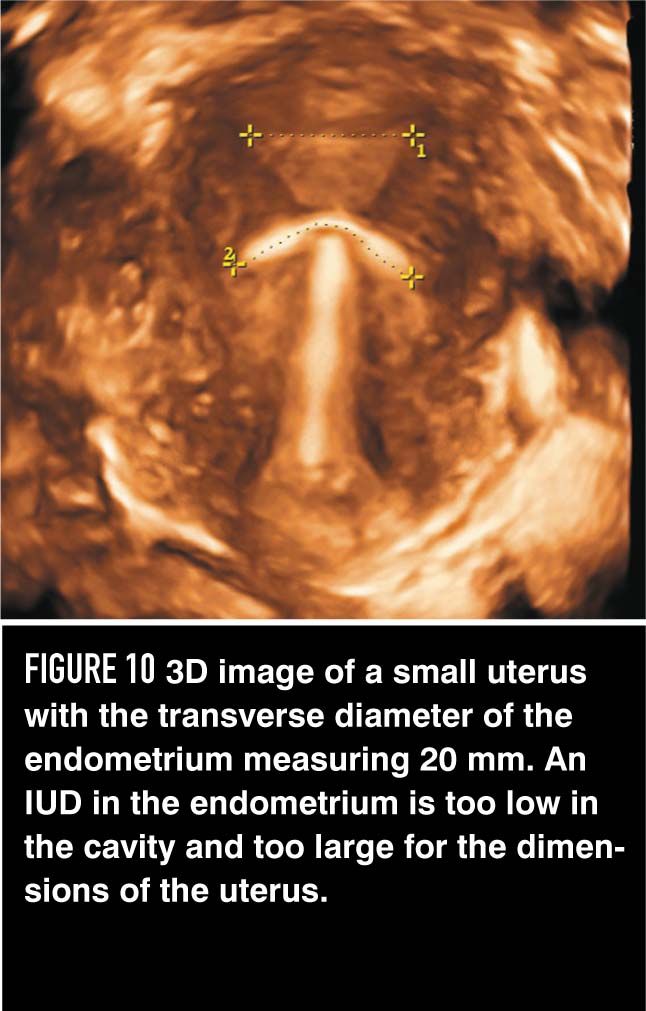
Further research is needed before an evidence-based recommendations can be made about IUD use in women with uterine anomalies.
IUDs have increasingly been inserted immediately postpartum, including following cesarean delivery. The advantage is a higher proportion of continued IUD use at 6 months postpartum when compared to interval IUD placement; however, approximately one-quarter are expelled or removed for malposition by 6 weeks postpartum.18,19
Guided insertion, removal
IUDs can typically be inserted and removed in straightforward office procedures. At times, however, ultrasound can be uniquely advantageous in assisting both insertion and removal of the devices. If a patient’s uterus is severely anteverted or retroverted, direct sonographic visualization can offer some reassurance to a clinician that the IUD is being appropriately placed within the uterus (Video). Similar difficulties may be encountered when an IUD is removed. At times the string may not be visible if it has retracted into the uterus or the IUD is partially embedded. In those cases, removal under direct ultrasound guidance may offer great benefit, avoiding the need to do the procedure in the operating room20 (Video).
References
1. Branum AM, Jones J. Trends in long-acting reversible contraception use among U.S. women aged 15-44. National Center for Health Statistics Data Brief, Number 188, February 2015.
2. Lethaby A, Munawar H, Rishworth JR, Rees MC. Progesterone or progestogen-releasing intrauterine systems for heavy menstrual bleeding. (Review) The Cochrane Collaboration. 2015.
3. Long-acting reversible contraception: implants and intrauterine devices. American College of Obstetricians and Gynecologists. Practice Bulletin Number 121, July 2011, Reaffirmed 2013.
4. Benacerraf BR, Shipp TD, Bromley B. Three-dimensional ultrasound detection of abnormally located intrauterine contraceptive devices which are a source of pelvic pain and abnormal bleeding. Ultrasound Obstet Gynecol. 2009;34:110–115.
5. Benacerraf BR, Abuhamad AZ, Bromley B. et al. Consider ultrasound first for imaging the female pelvis. Am J Obstet Gynecol. 2015;212:450–455.
6. Sakhel K, Benson CB, Platt LD, et al. Begin with the basics. Role of 3-dimensional sonography as a first-line imaging technique in the cost-effective evaluation of gynecologic pelvic disease. J Ultrasound Med. 2013;32:381–388.
7. Shipp TD, Bromley B, Benacerraf BR. The width of the uterine cavity is narrower in patients with an embedded intrauterine device (IUD) compared to a normally positioned IUD. J Ultrasound Med. 2010;29:1453–1456.
8. Moschos E, Twickler DM. Does the type of intrauterine device affect conspicuity on 2D and 3D ultrasound? AJR. 2011;196:1439–1443.
9. Chen XY, Guo QY, Wang W, Huang LL. Three-dimensional ultrasonography versus two-dimensional ultrasonography for the diagnosis of intrauterine device malposition. Int J Gyn Obstet. 2015;128:157–159.
10. Nowitzki KM, Hoimes ML, Chen B, Zheng LZ, Kim YH. Ultrasonography of intrauterine devices. Ultrasonography 2015;34:183-194.
11. Agacayak E, Tunc SY, Icen MS, Oguz A, Ozler A, Turgut A, Basaranoglu S. Evaluation of predisposing factors, diagnostic and treatment methods in patients with translocation of intrauterine devices. Obstet Gynaecol Res. 2015;41:735–741.
12. Abuhamad AZ, Singleton S, Zhao Y, Bocca S. The Z Technique: An easy approach to the display of the midcoronal plane of the uterus in volume sonography. J Ultrasound Med. 2016;25:607–612.
13. Valsky DV, Cohen SM, Hochner-Celnikier D. et al. The Shadow of the Intrauterine Device. J Ultrasound Med. 2006;25:613–616.
14. Asch E, Levine D, Brook OR. Fractured intrauterine device copper sheath with an intact Polyethylene Core. J Ultrasound Med. 2013;32:1877–1878.
15. Braaten KP, Benson CB, Maurer R, Goldberg AB. Malpositioned intrauterine contraceptive devices; risk factors, outcomes, and future pregnancies. Obstet Gynecol. 2011;118:1014–1020.
16. Anteby E, Revel A, Ben-Chetrit A et al. Intrauterine device failure: relation to its location within the uterine cavity. Obstet Gynecol. 1993;81:112–114.
17. Liang H, Li L, Yuan W, Zou Y, Gao E-S, Duffy JMN, Wu S-C. Dimensions of the endometrial cavity and intrauterine device expulsion or removal for displacement: a nested case-control study. BJOG. 2014;121:997–1004.
18. Levi EE, Stuart GS, Zerden ML, Garrett JM, Bryant AG. Intrauterine device placement during Cesarean delivery and continued use 6 months postpartum. Obstet Gynecol. 2015;126:5–11.
19. Dias T, Abeykoon S, Kumarasiri S, Gunawardena C, Padeniya T, D’Antonio F. Use of ultrasound in predicting success of intrauterine contraceptive device insertion immediately after delivery. Ultrasound Obstet Gynecol. 2015;46:104–108.
20. Verma U, Astudillo-Dávalos FE, Gerkowicz SA. Safe and cost-effective ultrasound guided removal of retained intrauterine device: our experience. Contraception. 2015;92:77–80.
Newsletter
Get the latest clinical updates, case studies, and expert commentary in obstetric and gynecologic care. Sign up now to stay informed.
MRI and ultrasound models may reduce macrosomia risks in primigravid women
July 31st 2025Utilizing magnetic resonance imaging and ultrasound models to predict fetal weight in primigravid women can significantly reduce macrosomia-related adverse outcomes, with MRI showing superior accuracy.
Read More
Using technology tools for optimal perinatal outcomes
July 31st 2025At the 2022 American College of Obstetricians and Gynecologists Annual Clinical and Scientific Meeting, 3 physicians talked about how apps, AI and remote blood pressure monitoring could improve perinatal outcomes and move the diversity, inclusion, and equity needle for women forward.
Read More
Ultrasound vs. MRI to detect uterine leiomyomas
July 31st 2025A prospective observational study in the Journal of Ultrasound in Medicine has concluded that for pretreatment evaluation of uterine fibroids (UF), transabdominal contrast-enhanced ultrasound (CEUS) represents a viable alternative to traditional contrast-enhanced magnetic resonance imaging (MRI).
Read More
